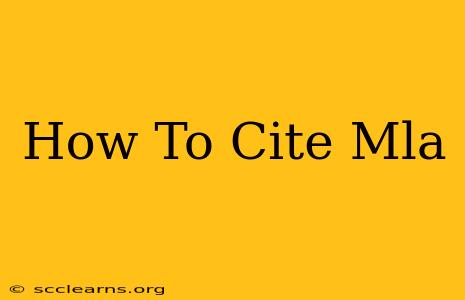MLA (Modern Language Association) style is widely used in humanities disciplines for citing sources. Mastering MLA citation is crucial for avoiding plagiarism and showcasing your research. This guide provides a comprehensive overview of how to cite MLA, covering in-text citations and the Works Cited page.
Understanding MLA Citation Basics
Before diving into specifics, let's establish the core principles of MLA citation:
- Accuracy: Ensure all information is precise and verifiable. A small error can invalidate your entire citation.
- Consistency: Maintain a consistent format throughout your paper. Inconsistency detracts from credibility.
- Completeness: Include all necessary information for each source. This typically includes author, title, publication information, and date.
In-Text Citations: Giving Credit Where Credit is Due
In-text citations are brief references within your text that correspond to entries in your Works Cited page. They help readers easily locate the full source information.
Different Types of In-Text Citations:
-
Author-Page Method (Most Common): This method uses the author's last name and page number(s). For example: (Smith 123). If the author's name is mentioned in the sentence, only the page number is needed: Smith argues this point effectively (123).
-
No Author: If a source lacks an author, use a shortened version of the title in place of the author's name. For example: ("Impact of Climate Change" 45). Use quotation marks around the title if it's a short work (like an article).
-
Multiple Authors: For two authors, list both last names (Smith and Jones 78). For three or more, use the first author's last name followed by "et al." (Smith et al. 90).
-
Multiple Works by the Same Author: If you cite multiple works by the same author, include a shortened title to distinguish between them. For example: (Smith, Theories of Language 25) and (Smith, Syntax and Semantics 100).
-
Indirect Sources: If you cite a source that quotes another source, use "qtd. in" to indicate the indirect source. For example: (Smith qtd. in Jones 150). This means that Smith is the original source, but you found the quote in Jones' work.
The Works Cited Page: Your Source Guide
The Works Cited page, placed at the end of your paper, provides the complete bibliographic information for each source cited in your text. It follows a specific format:
- Heading: Center the title "Works Cited" at the top of the page.
- Alphabetical Order: List sources alphabetically by the first word of each entry (usually the author's last name).
- Hanging Indents: Use hanging indents, where the first line of each entry is flush left and subsequent lines are indented.
- Consistency: Maintain consistent punctuation and capitalization throughout.
Examples of MLA Citations:
Here are a few common source types and their corresponding MLA citations:
Book:
In-text: (Smith 123)
Works Cited:
Smith, John. Title of Book. Publisher, Year.
Journal Article:
In-text: (Jones 45)
Works Cited:
Jones, Jane. "Title of Article." Title of Journal, vol. number, no. number, Year, pp. page range.
Website:
In-text: ("Website Title" para. 3)
Works Cited:
"Website Title." Website Name, URL, Access Date.
Mastering MLA Citation: Key Takeaways
Remember that accuracy, consistency, and completeness are essential. Familiarize yourself with the specific formatting rules for different source types. Using a reliable style guide or citation management tool can greatly assist in the process. Though this guide provides a solid foundation, always consult the latest edition of the MLA Handbook for the most up-to-date information and to handle any specific situations not covered here. Proper MLA citation is critical for academic integrity and effective communication.

